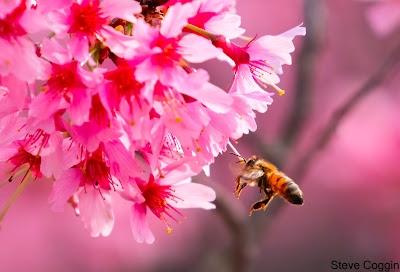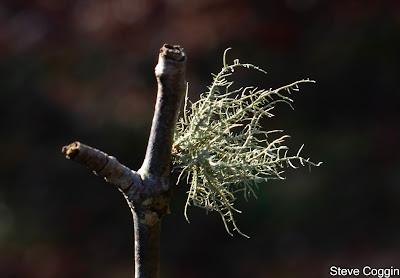 |
| Flowers of East Asian Cherry (Prunus serrulata). Rowan County, North Carolina. |
We have a venerable East Asian Cherry (Prunus serrulata) in our back yead. It leafs out and flowers early each spring. It is also the first tree in our yard to lose its leaves in the fall. By the first week of March its branches are laden with thousands of pink flowers. These in turn attract swarms of Honeybees (Apis mellifera) and other early pollinators. On sunny spring days the tree is abuzz with the bees. The tree also attracts birds throughout the year feeding on the abundance of insects there. But other, more subtle forms of life are also in the cherry.
 |
| A Honeybee pollinating East Asian Cherry. Rowan County, North Carolina. |
 |
| Pine Siskin (Spinus pinus) feeding amidst the flowers of East Asian Cherry. Rowan County, North Carolina. |
A winter storm blew through our neighborhood last week dumping two and a half inches of rain, knocking out the power for 12 hours and dropping untold numbers of sticks and branches into our yard. One of these branches, from our East Asian Cherry, was encrusted with fungi and lichens.
The most colorful of these fungi was Witch’s Butter (Tremella mesenterica). This bright yellow blob was emerging from cracks in the bark. The Witch’s Butter fungus breaks down dead wood, so this branch was dead while still attached to the tree.
 |
| Witch's Butter (Tremella mesenterica) emerging from the branch. Rowan County, North Carolina. |
Giraffe fungus (Peniophora albobadia) is another wood decaying fungus that made a striking display on the branch. It makes brown patches rimmed by white, much like the spots on a Giraffe (Giraffa sp).
 |
| Giraffe Fungus (Peniophora albobadia) growing on the branch. Rowan County, North Carolina. |
At least three different lichens were also on the branch. Lichens are symbiotic organisms made up of a fungus and a photosynthetic alga. A single, one-inch clump of Usnea strigosa, Beard Lichen, was on the branch. This lichen grows about 1 inch per year, so the branch was probably dead for at least a year before it was blown from the tree in the storm.
 |
| Beard Lichen (Usnea strigosa). Rowan County, North Carolina. |
There were several clumps of the foliose lichen Parmotrema perforatum on the branch. This gray green lichen has a leaf-like structure with black filaments called cilia along its margins. These cilia probably act to catch dew for the rootless lichen.
 |
| Parmotrema perforatum with cilia. Rowan County, North Carolina. |
Several Common
Button Lichens (Buellia erubescens) were growing on the branch. This is a crustose lichen that grows tightly
appressed to the bark of trees. Common
Button Lichens are light gray with black spore producing structures called
apothecia.
 |
| Common Button Lichen (Buellia erubescens). Rowan County, North Carolina. |
Even in winter, when we think not nothing is happening in a tree, much is still going on. It is a
wonder that a single dead branch from a cherry tree could play host to so many different fungi. But visual examination only scratches the
surface of this diversity because most fungi are microscopic. This branch, blown
from a tree by a storm, is an inspiration to look closely at the natural world.
No comments:
Post a Comment